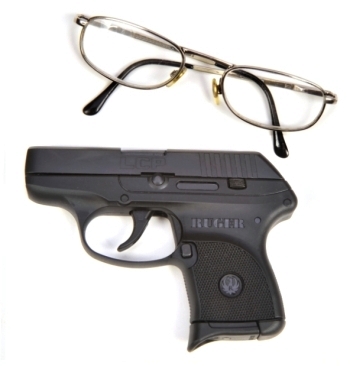
I’d been looking for a small .380 ACP ever since I shot a smoked over Colt Mustang. The product of some very clean gunsmithing, the trigger was excellent and the gun shot really well, making smaller than cloverleaf groups at seven yards. I looked around for one of my own at that time, but couldn’t find a comparable gun.
All .380 ACP pistols are not created equal as quality of manufacturing and design run the gamut from precision made and properly scaled to stamped sheet metal wonders. Some guns share their design with 9mm Luger model firearms that have been reduced only in chamber to accommodate the .380 ACP. The result is an odd combination of big gun and small cartridge. Today, any and all .380 ACPs are in short supply and prices have skyrocketed, so the Ruger LCP was a welcome find.
So what do you do with a .380 ACP?
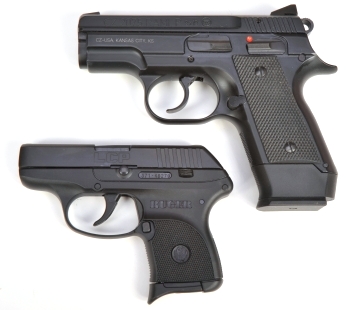 The short answer is that you can protect yourself when no one else is willing or able, and a compact .380 ACP provides that protection discretely and conveniently. Ruger’s LCP is dwarfed by even the very compact 9mm CZ 2075. In these days of anonymous neighbors and local government’s preoccupation with thinking green rather than emergency response, self reliance rules the day. I carry at the shop, when I’m out fishing or hunting and in the evenings around the house. All the .380 ACP needs to do is allow me to marshal a respectable defense in the face of an immediate threat, like a home invasion, and give me time to get to more significant firepower. A larger gun would be too uncomfortable to wear with such frequency and would end up being stowed.
The short answer is that you can protect yourself when no one else is willing or able, and a compact .380 ACP provides that protection discretely and conveniently. Ruger’s LCP is dwarfed by even the very compact 9mm CZ 2075. In these days of anonymous neighbors and local government’s preoccupation with thinking green rather than emergency response, self reliance rules the day. I carry at the shop, when I’m out fishing or hunting and in the evenings around the house. All the .380 ACP needs to do is allow me to marshal a respectable defense in the face of an immediate threat, like a home invasion, and give me time to get to more significant firepower. A larger gun would be too uncomfortable to wear with such frequency and would end up being stowed.

A little more detail, please… Sure.
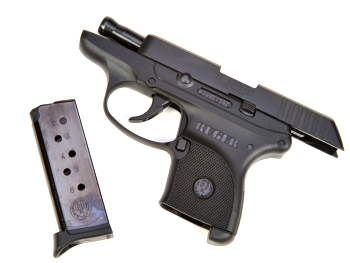
I have no idea who is doing the aesthetic design work over at Ruger, but Ruger needs to keep that person or group happy and in their employ. A micro size gun, the LCP still provides excellent control geometry. Its overall form and finish make it a practical gun to carry and one that is pleasing.
Poly and steel, with a matte black finish. the LCP looks and feels substantial. I passed on a lot of .380s because they were oversized for the cartridge, or small but difficult to control. Ruger seems to have put a lot of thought into the design of this pistol and arrived at an optimal result.
|
The slide hold open, Ruger nomenclature, is manually set, the slide does not lock open on an empty mag and inserting a magazine will not release a slide that has been manually locked open. However, because the hold open is spring loaded in the down position, a little tug on the back of the slide with release the hold open and allow the slide to move forward, chamber a round and then move into the locked and loaded position.
There are no internal key locks or magazine disconnect linkage. In fact, the gun has few moving part, even fewer exposed parts which, to me, spells reliability of operation and no weak mechanisms that can break and render the gun inoperative under stress.
Functionally…
The LCP is labeled “Single strike double action”. I assume this is in regard to the hammer being moved into a half cocked position during the first ½” of slide travel and not by initial trigger squeeze. Once the slide has cycled, the trigger pull moves the hammer the rest of the way to full cocked and then onto release. The sequence and hammer positions are illustrated in the picture below.

The result is the safety of a double action autoloader with a relatively light trigger pull as the trigger is not rotating the hammer rearward for the first part of travel where resistance would be heavy. On the other hand, if there is a misfire, there is no second pull of the trigger to detonate a hard or mis-seated primer. Instead, the gun is cleared by cycling the slide and dumping the bad round.
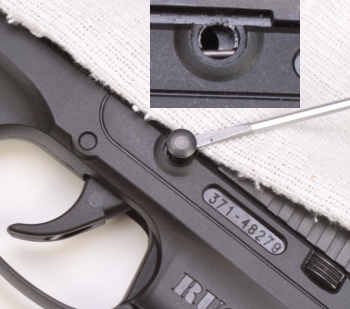
The LCP comes apart easily. The magazine is removed and the slide is cycled to check for an empty chamber. The take down pin, Ruger vernacular, is removed by moving the slide rearward approximately ⅛” then prying the head of the pin upward with a thin screw driver. I really hate stating that instruction. I suggest putting a cloth over the slide to prevent scratches. You will want to skip attempting pin removal with your finger nails – it’s not going to happen. As pictured, the pin is held in place with a take down pin detent, which must be overcome for pin removal and installation. The takedown pin is not a through pin, so there is no option available for pushing through from the opposite side.
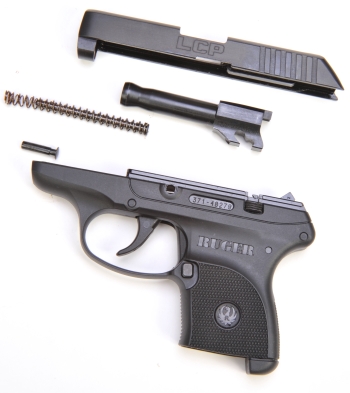
With the take down pin removed, the slide is moved forward and off, carrying with it the barrel and double recoil spring. To remove the barrel, the guide rod and inner and out recoil springs are removed, the breech end is pulled downward and the barrel is pulled to the rear.
The barrel locks up on the fore and aft lug surfaces above and at either end of the chamber portion of the barrel. There are no radial lugs on the barrel as they appear on a 1911 type gun. When the gun is discharged, the barrel and slide are locked together, both move aft. After very short travel, when the bullet has left the barrel and pressure has dropped to zero, the rear of the barrel cams downward and unlocks from the slide. The slide continues rearward on its own to extract and eject a casing, then comes forward to chamber another round.
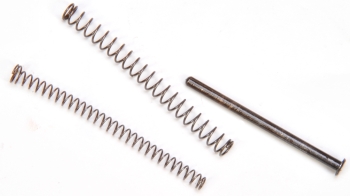
The recoil springs are quite small in wire gauge and diameter, however, they only have to damped slide motion caused by the little .380’s bullet kinetic energy after pressure has gone from 21,500 PSI to zero and the action is unlocked. I do not know the spec for the springs, but in combination they measure approximately 5 lbs when compressed to just short of coil bind. There are cautions all over the gun’s manual to not shoot higher than SAAMI spec pressure ammunition, including +P loads.
The great no .380 ACP ammo dilemma..
The Ruger manual, unlike some of the other Ruger manuals, is emphatic about the use of factory .380 ACP ammo in the LCP. I don’t believe this is a statement regarding the strength of the firearm or an editorialized opinion on handloading. I do believe this is the expression of a manufacturer that wants to ensure a gun they sell will operate correctly under all intended circumstances. The smaller the round, the smaller the gun, the more sensitive the combination is to mechanical influences. Unfortunately, the supply of .380 ACP was dried up at the time this project was conducted. So I picked up a set of Hornady handloading dies, I had a supply of representative bullets and powder, then went on to scrounge brass.
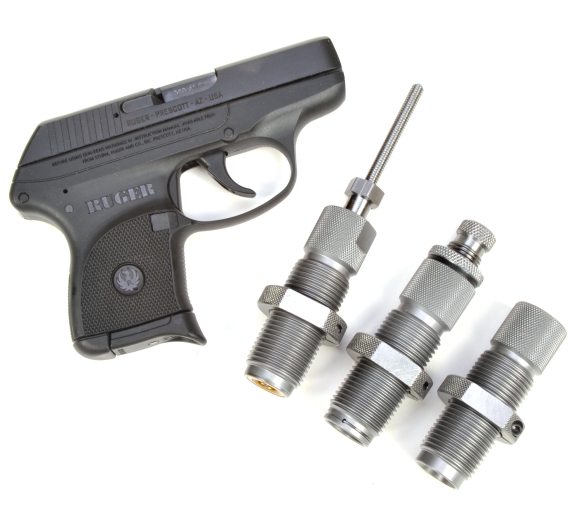
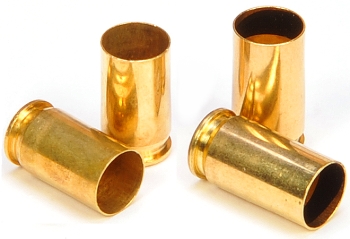 For me, buying fired brass from the Internet is a last resort. Most found on auction sites is actually range sweepings and, regardless condition stated, they will have other casings mixed in, sometimes cases that have been loaded with corrosive primers and/or cases that had been reloaded numerous times. So I buy them only in an emergency.
For me, buying fired brass from the Internet is a last resort. Most found on auction sites is actually range sweepings and, regardless condition stated, they will have other casings mixed in, sometimes cases that have been loaded with corrosive primers and/or cases that had been reloaded numerous times. So I buy them only in an emergency.
In this circumstance I bought 1,000 empties, tossed a 5% as incorrect cases, tossed a third as being exposed to corrosive primers or had seen prior cycles of reloading, then I hand sorted out a couple hundred Winchester and Remington cases for the project. These were decapped, primer pockets cleaned and then washed in ZEP Professional Citrus Cleaner, undiluted, for about half an hour. They were then dried, tumbled and inspected again, ending up as they looked above, sitting next to new 9mm Luger factory brass.
I hated loading these little things…
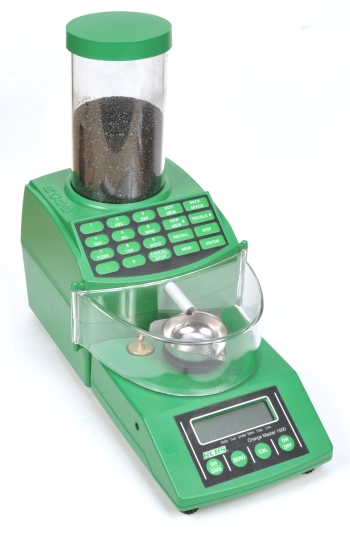 When you handload something big that really goes boom and kicks and squawks you feel like you’ve accomplished something. When you load up a pile of these little jelly bean size rounds, you do it for the good of the project. Beside, I promised the gun to my wife when the project was completed so I was under considerable pressure to make ammo. No mercy for an old guy.
When you handload something big that really goes boom and kicks and squawks you feel like you’ve accomplished something. When you load up a pile of these little jelly bean size rounds, you do it for the good of the project. Beside, I promised the gun to my wife when the project was completed so I was under considerable pressure to make ammo. No mercy for an old guy.
I would have preferred to load with a Lee Precision seater die and factory crimp die because of the .380’s extremely short case and easy to crinkle construction. The Hornady New Dimension dies were excellent for sizing and expanding, Most of the time the caliber rather than cartridge specific seater is a big plus, but this time the all purpose approach to a seater provided too little support to the .380 ACP and not enough adjustment for a taper crimp. The Lee seater also acts as an assembled round sizing die, making sure case have not been over expanded and will chamber. The factory crimp die does a good job of crimping without deforming cases by applying lateral rather than axial force to crimp..
I don’t use mechanical powder measures with any frequency. Usually, project requirements are too critical to live with the charge variances so I end up scaling each charge. Charging cases with fast powder is something that requires more care than a mechanical measure can generally provide as fast powder is more volatile than slow. Throw an extra half grain when you’re filling a hundred grain case and it would hardly be noticed. Throw an extra half grain in a six grain case and you could be headed toward unplanned and rapid pistol disassembly. The RCBS ChargeMaster threw both 4 and 4.2 grain charges consistently and without error at a rate of 160 charges per hour, which was just fine for my purposes.
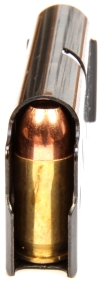 COL for the .380 ACP and LCP is critical. The magazine at the left contains a handload that is only 0.960″ in overall length in comparison to the SAAMI maximum spec length of 0.984″. However, the bullet has a wide hollow nose cavity and a blunt ogive so .960″ is maximum length without binding in the magazine. Care must also be taken to not seat longer bullets too deeply and against the case’s interior web and cause it to buckle. The bullet in the magazine is a Nosler 115 grain HP, however, the same length restriction applied to the 80 grain Barnes M/LE bullets. Both were loaded to 0.960″ COL.
COL for the .380 ACP and LCP is critical. The magazine at the left contains a handload that is only 0.960″ in overall length in comparison to the SAAMI maximum spec length of 0.984″. However, the bullet has a wide hollow nose cavity and a blunt ogive so .960″ is maximum length without binding in the magazine. Care must also be taken to not seat longer bullets too deeply and against the case’s interior web and cause it to buckle. The bullet in the magazine is a Nosler 115 grain HP, however, the same length restriction applied to the 80 grain Barnes M/LE bullets. Both were loaded to 0.960″ COL.
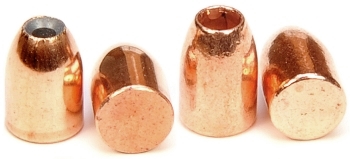
HS-6 was selected as a single powder type. By the time a bullet was seated, the 380 ACP case’s 12 grains of powder capacity was reduced to half, so a fast pistol powder was about the best selection. There were other powders that could have been substituted, however, HS-6 burns clean and it is a dense powder. The loads were:
Small Pistol Primer
80 grain Barnes M/LE bullet
4.3 grains HS-6
0.960″ COL
Chronograph 802 fpsSmall Pistol Primer
115 Grain Nosler Sporting Handgun bullet
4.1 grains HS-6
0.960″ COL
Chronograph 606 fps
Don’t fall asleep yet…things actually got exciting
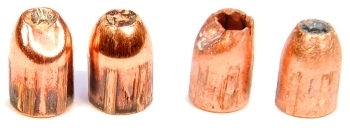
After an extensive amount of time spent shooting bullets from short barrel guns into test medium of various types, I’ve come to accept there are approximately two bullet types that will expand at reduced velocities, Remington Golden Saber and Winchester Silvertip. That’s great if these bullets are being pushed ahead of a substantial cartridge, but even here the downside is that they expand to nearly double their size and penetrate only about half the distance of other manufacturer’s products of tougher construction. The .380 ACP is the same diameter as the 9mm Luger and .357 SIG, it just doesn’t have the powder behind it to penetrate as much, so expansion may even diminish the round’s lethality.
This particular Barnes bullet, the M/LE is only 80 grains in weight but designed for penetration. The Nosler, 35 grains heavier and heavy by any measure for the .380 ACP, is intended to expand. Test blocks of ¼” pine plywood were made up, six layers held together with elastic bands. The Barnes bullet completely penetrated one layer and came to a stop halfway through the second. The Nosler bullet penetrated two layers and came to rest in the third. They are the two bullets to the left in the photo above, Barnes and Nosler respectively. The bullets to the right were pulled from sawdust, sand and water mixture, Barnes and Nosler respectively, the Barnes bullet penetrated 8¾” without expanding, the Nosler bullet 15½” also without expanding. Interesting development as I was only able to find one listing for commercially assembled 115 grain ammo. I’m going to look into bullets and ammo in the 100 grain range and see what kind of results it will produce.
So what about this little Ruger LCP?
 I’m a believer. What I have seen so far suggest it is a lethal compact pistol that is easy to control and not particularly fussy about ammo as long as COL and ogive are in line with what the gun’s magazine can feed. It is easy to take down and clean and the trigger pull is actually quite light for a gun of this type. I probably have to accept my wife is not going to return this one, so I will just have to find another.
I’m a believer. What I have seen so far suggest it is a lethal compact pistol that is easy to control and not particularly fussy about ammo as long as COL and ogive are in line with what the gun’s magazine can feed. It is easy to take down and clean and the trigger pull is actually quite light for a gun of this type. I probably have to accept my wife is not going to return this one, so I will just have to find another.
Wish list items? A shorter trigger pull. The trigger starts well forward and has a substantial arc. Not hard to overcome to develop shooting comfort and accuracy, but it does require concentration. It would be nice to have a second magazine packed with each gun. But is all fairness, the price is so low I was surprise at the high quality of the gun so maybe not packing in a lot of extras is better for most customers. That’s it, great little gun and the best .380 ACP I have shot for a very long time.

Email Notification